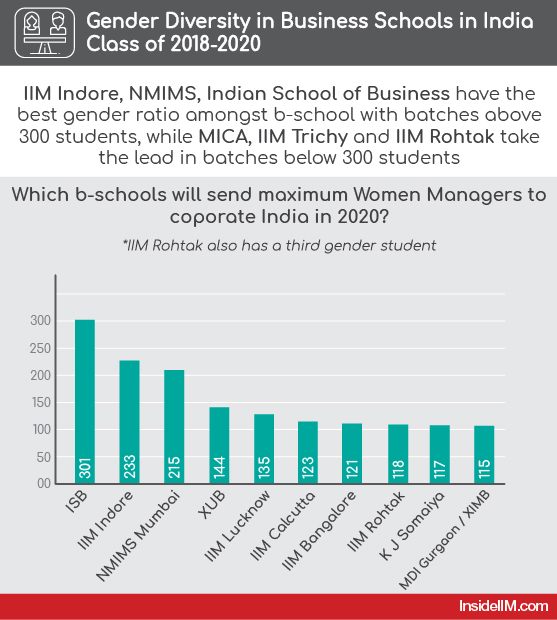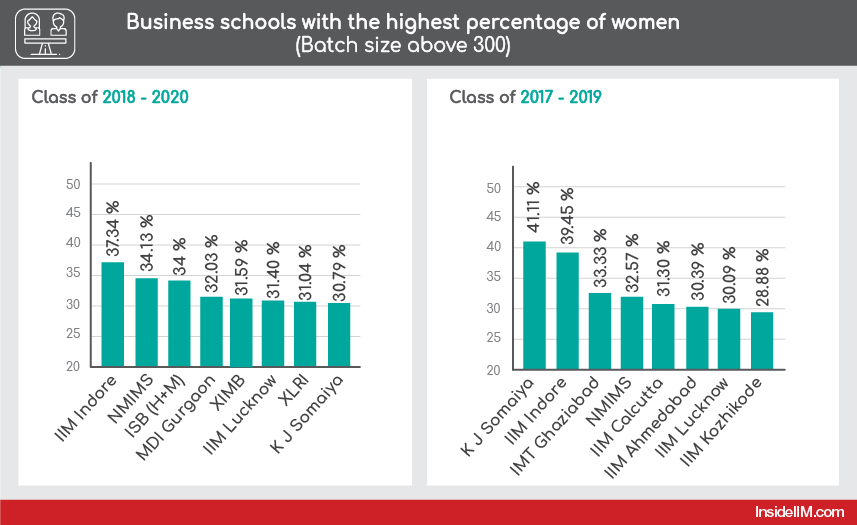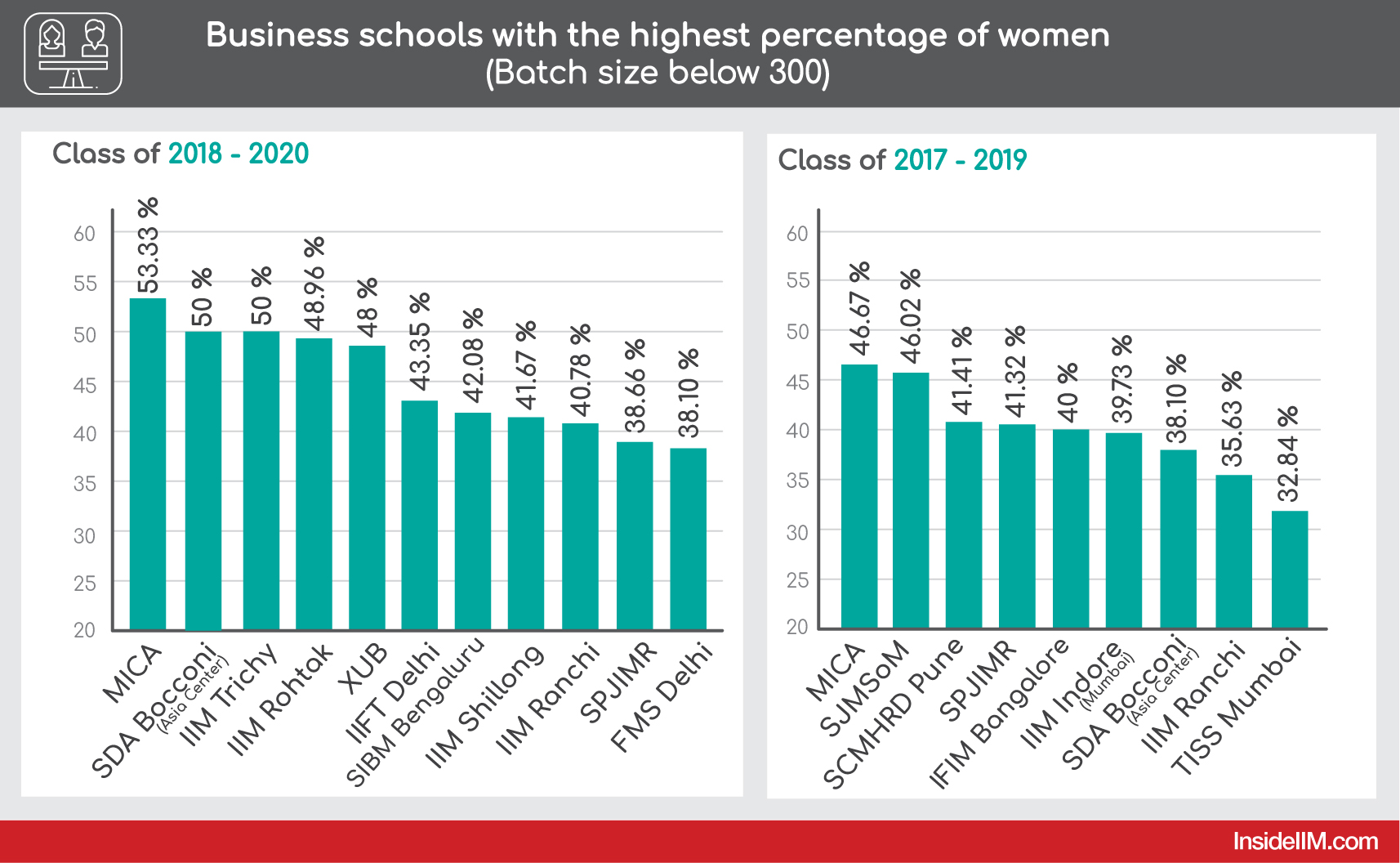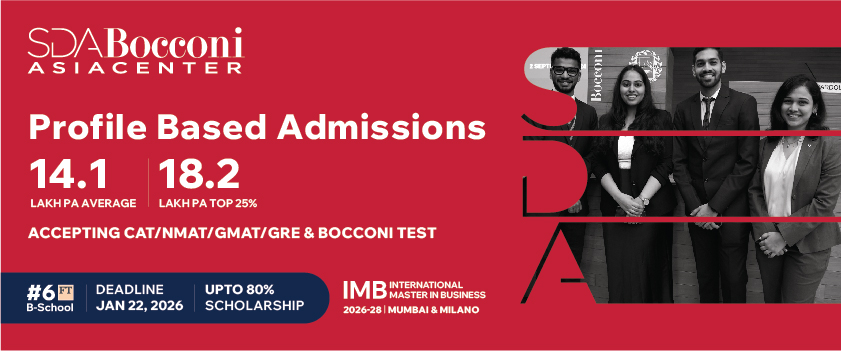Gender diversity has been a major concern for both b-schools and corporates alike, with industries demanding a more diverse work-force and capitalizing on the potential of female workers. The InsideIIM Gender Diversity Reports address this concern and portray the on-ground gender statistics in India's premier b-schools.
Highlights of the report -
- When it comes to IIMs, IIM Indore, IIM Trichy and IIM Rohtak come out on top as the most gender-diverse b-schools. On the other end of the spectrum, IIMs Sirmaur and Sambalpur suffer from the least gender-diverse batches in 2018.
- FMS has seen a colossal 110% increase in the number of female candidates for their MBA batch, therefore setting a benchmark for other management institutes.
- SDA Bocconi Asia Center and IIM Trichy have 1:1 gender ratio. MICA has a higher percentage of women in its batch; no other b-school has been able to achieve this feat.
- As compared to previous year's data, SJMSoM has seen the biggest drop in the percentage of women who are a part of their Master of Management programme, seeing a drop of close to 30 percentage points.
- While for the batch of 2017-2019, KJ Somaiya was leading the pack as one of the most gender-diverse b-schools, it has fallen behind a significant number of its counterparts for the Class of 2020.
2017 was marked as the year of the highest recorded women applicants for CAT in the last 5 years. Even though there is a growth in the number of women who are now pursuing higher studies, there isn't much representation seen in the corporate framework. More so, even business schools are yet to see a balanced gender ratio.
In this report, we study the data from the top b-schools in the country to understand why some may have a higher gender ratio than the others. Over the years b-schools have understood the importance of inter-gender interactions and have welcomed applications from women candidates. While we may see some of the top b-schools having a disheartening gender ratio, it is important to understand how the other schools have managed to maintain a healthy ratio.
Let us look at data for the Class of 2020. This report looks at 34 b-schools that have shared data with us. (If your b-school has a higher ratio but still hasn’t featured in this list, it is not because we don’t like your school, it is because the data wasn’t shared with us. Please feel free to send your batch’s details (total number of students and the total number of women in the class of 2020) to nidhi.malkan@insideiim.com.

*ISB is a one year program. 301 women to enter corporate India in 2019 from ISB.
Let’s also take a look at the top b-schools with the highest percentage of women from last year and compare the chart of this year’s top b-schools with the highest percentage of women.


After analyzing the data from over 34 schools, it is safe to say that size does matter. It is tougher to maintain a good gender ratio with a batch of 500+ students as opposed to having a batch of 75 or even 150 students.
However, a lot has changed over the last 5 years. More women are registering for CAT and are competitive about getting into the tier-1 schools. A slightly liberal admission criterion has also worked positively in ensuring a more gender-diverse batch in some of India’s top schools.
Gender Diversity Ratio at B-Schools with a batch of more than 300 Students – Class of 2020*
| Business School | Program | Batch Size | Total Number of Women | Third Gender | % of Women |
| IIM Indore | PGP+IPM (students entering final two years of IPM) | 624 | 233 | 0 | 37.34% |
| NMIMS Mumbai | SBM | 630 | 215 | 0 | 34.13% |
| ISB (Hyderabad + Mohali) |
PGP | 887 | 301 | 0 | 34.00% |
| MDI-Gurgaon | PGPM+PGP-HRM+PGPIM | 359 | 115 | 0 | 32.03% |
| XIMB | BM | 364 | 115 | 0 | 31.59% |
| IIM Lucknow | PGP | 430 | 135 | 0 | 31.40% |
| XLRI | BM+HR | 364 | 113 | 0 | 31.04% |
| KJ Somaiya | Core+IB+RM+FS+Comm+HS | 380 | 117 | 0 | 30.79% |
| IIM Bangalore | PGP | 430 | 121 | 0 | 28.14% |
| IIM Calcutta | PGP | 462 | 123 | 0 | 26.62% |
| IIM Kozhikode | PGP | 422 | 101 | 0 | 23.93% |
| IMT-Ghaziabad | PGDM | 500 | 90 | 0 | 18.00% |
Note - In the initial version of this report, IIM Calcutta's percentage of women was 43.29% (200 women), but the institute has changed that figure to 123 women (26.62%) women on 12th September 2018.
ISB (when taken account of both the Hyderabad and Mohali campus) will send the most amount of women managers to the industry in 2019. It is followed by last years champions - IIM Indore and NMIMS Mumbai.
However, if the ratio and its percentage are to be considered, IIM Indore steals the thunder, with close to 40% of the PGP students being female. There are 233 females students in a batch of 624. This is also a result of extra marks being allocated to female applicants. However, as compared to last year, there has been a drop in IIM Indore’s percentage of women from a consistent 40% to 37.34%.
We are reporting ISB’s stats for the first time and while it may not rank the highest according to the gender ratio of the batch, it will send out the most number of female managers in 2019. In a batch of 887 students, 301 are female, which accounts for 34%.
XLRI seems to have its numbers gradually rising up from 27% to 31.04%, while IMT Ghaziabad has seen a downfall from its usual 30%+ to a meagre 18% this year.
It is also worth noting that NMIMS Mumbai with a batch of almost 700 students has managed to keep the percentage of women on campus above 30%. NMIMS will send 215 women to Corporate India in 2020. This is despite the fact that they do not award any additional points for female applicants. This could be because the cutoff for NMAT is quite reasonable and NMIMS puts a decent weight on Academics, Personal Interview, and Case Discussions.
Also to be noted is that, in a major step to improve the gender ratio, IIM Kozhikode has announced 60 seats for female candidates for the PGP batch of 2019-2021.
Gender Diversity Ratio at Top B-Schools with a batch of 300 Students or less, but more than 150 – Class of 2020
Business School |
Program |
Batch Size |
Total Number of Women |
Third Gender |
% of Women |
MICA |
PGDMC |
180 |
96 |
0 |
53.33% |
IIM Tiruchirappalli |
PGPM |
183 |
92 |
0 |
50.00% |
IIM Rohtak |
PGP |
241 |
118 |
1 |
48.96% |
XUB |
XAHR + XSRM + XSC - MBF + XSoS + XUMG |
300 |
144 |
0 |
48.00% |
IIFT Delhi |
MBA-IB |
173 |
75 |
0 |
43.35% |
SIBM Bengaluru |
MBA |
202 |
85 |
0 |
42.08% |
IIM Shillong |
PGP |
180 |
75 |
0 |
41.67% |
IIM Ranchi |
PGDM+PGDHRM |
255 |
104 |
0 |
40.78% |
SPJIMR |
PGDM |
238 |
92 |
0 |
38.66% |
FMS Delhi |
MBA |
231 |
88 |
0 |
38.10% |
IFMR |
MBA |
187 |
66 |
0 |
35.29% |
IIM Udaipur |
PGP |
265 |
65 |
0 |
24.53% |
IIM Raipur |
PGP |
209 |
42 |
0 |
20.10% |
IIFT Kolkata |
MBA-IB |
153 |
29 |
0 |
18.95% |
NITIE |
PGDIM |
241 |
32 |
0 |
13.28% |
MICA maintains its position as the most gender-diverse b-school with 53.33% women in its 2020 batch. There have been years where the number of women has been more than the number of men.
IIM Trichy, IIM Rohtak, and XUB follow close with 50%, 48.96% and 48% women in its most recent batch respectively. Founded in 2009, IIM Rohtak and IIM Trichy are the more recent IIMs but have been garnering attention with 100% placements from top recruiters. It also gives points to its female applicants. XUB’s total strength inclusive of all their courses offered is 300, of which 144 students are female.
Unlike the previous year, IIM Rohtak, IIM Shillong, and IIM Trichy have good gender ratios.
SPJIMR shows a small drop in its gender diversity ratio. Last year SPJIMR’s gender ratio was 41.23% and it has come down to 38.66%. It is a private b-school which gives a lot of weight on the profile of a person while selecting candidates and has always appreciated a good gender ratio.
The other standout b-schools are IIFT-Delhi, SIBM Bengaluru, IIM Ranchi and FMS. These schools have a good gender ratio, especially when compared with other b-schools with larger batch sizes. It is also interesting to note that FMS has seen a 110% increase in the intake of female students for the full-time MBA program since last year. This significant change has been credited to the change in the selection criteria - the weightage for CAT score was reduced from 85% to 60%, additional 10% weightage to 10th and 12th grades, and an introduction of the GD round.
IIFT Kolkata, IIM Udaipur, IIM Raipur, and NITIE are at the lower end of the charts and need to work on their gender ratio numbers.
Gender Diversity Ratio at Top B-Schools with a batch of less than 150 – Class of 2020
Business School |
Program |
Batch Size |
Total Number of Women |
Third Gender |
% of Women |
SDA Bocconi Asia Center |
IMB |
116 |
58 |
0 |
50.00% |
TISS Mumbai |
MA HR |
62 |
22 |
0 |
35.48% |
IIM Jammu |
PGP |
65 |
14 |
0 |
21.54% |
SJMSoM Mumbai |
MMP |
115 |
20 |
0 |
17.39% |
IIM Visakhapatnam |
PGP |
105 |
18 |
0 |
17.14% |
JBIMS Mumbai |
MMS |
137 |
17 |
0 |
12.41% |
IIM Sirmaur |
PGP |
99 |
1 |
0 |
1.01% |
IIM Sambalpur |
PGP |
97 |
0 |
0 |
0.00% |
SDA Bocconi has seen an increase in the number of female applicants, so much so that there are more female students than male. Their Women in Leadership Scholarship could be one of the major reasons for such a healthy gender diversity ratio.
SJMSoM has seen a massive drop from their last year’s numbers. As compared to last year’s 46.02% of female students, SJMSoM has now a weak display of 17.39% female students.
IIM Sirmaur finds itself in the same spot as 2016. Even though 2017 fetched a decent amount of female students for IIM Sirmaur, the b-school seems to be back to only 1 female student in a batch of 99 students.
IIM Sambalpur is part of the 3rd generations of IIMs that started in 2015. It fairs rather poorly in comparison to its sister-IIMs - IIM Jammu and IIM Visakhapatnam.
Schools with less than 150 students in a batch ought to have a better gender diversity ratio since it should be easier to ensure a lower absolute number of women who take admission.
Note: The data for IIM Lucknow, IIM Kozhikode and NMIMS is unverified.
Author's Note -
Times are changing. Back in the day, gender diversity meant having an equal pool of male and female participants. All the institutes, led by the IIMs started allocating weight points to women participants to balance the gender ratio.
The ratio of women in the top b-schools gradually increased, and the mission to make it an equilibrium pool still continues.
In the year 2014, the Supreme Court ruled in favour of the third gender with the Rights of Transgender Persons Bill. All top government institutions made room for another checkbox in their forms. In the very first year after the ruling, 80 participants registered for CAT under the transgender category. The top b-schools started allotting weight points for students of the third gender and prepared to welcome students on board. We are still to see a growth in the number of third gender students in top b-schools and even more, their placement in top corporate firms of the country.
(If your b-school has a higher ratio but still hasn’t featured in this list, it is possible that the data wasn’t shared with us)
In case you want your b-school to be featured on this list, please send the required stats to Nidhi at nidhi.malkan@insideiim.com
*This article was edited on 7th September 2018 at 16:30 pm.
